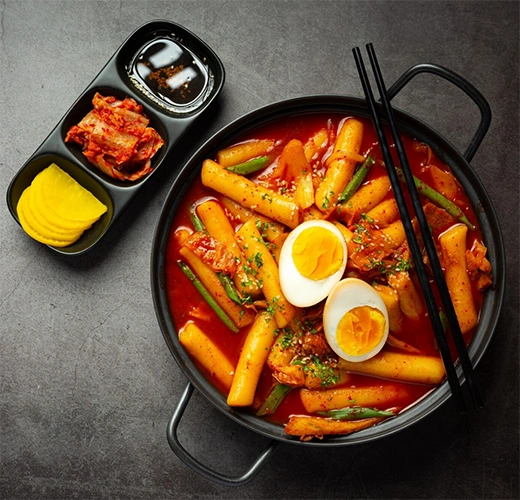

Top Health Benefits of Korean Tteokbokki You Need to Know
Tteokbokki is a comforting and energizing dish that provides a satisfying balance of macronutrients, particularly carbohydrates and moderate amounts of protein and fat. The primary ingredient, Korean rice cakes (tteok), is rich in complex carbohydrates, offering a quick energy boost, making it ideal for active individuals or post-workout meals. The addition of boiled eggs and fish cake contributes protein, supporting muscle repair and overall satiety. The spicy gochujang sauce, made from fermented chili paste, not only delivers bold flavor but also contains beneficial probiotics and capsaicin, which may support metabolism. Vegetables like onions, scallions, and carrots add dietary fiber, vitamins A and C, and antioxidants. Overall, while Tteokbokki is a calorie-dense dish, when enjoyed in moderation, it can be part of a nourishing and well-rounded meal.
Recipe :
Serves 4 People
Enjoy your spicy and savory homemade Korean Tteokbokki!
When preparing Tteokbokki, one of the most crucial steps is properly softening the rice cakes, especially if they are refrigerated or frozen — soak them in warm water for 10 to 15 minutes to ensure a chewy yet tender texture. The balance of flavors in the sauce is vital: gochujang provides heat and depth, but must be complemented with sweetness (typically from sugar or honey) and saltiness (from soy sauce) to achieve the characteristic spicy-sweet profile. Avoid overcooking the rice cakes, as they may become too soft and lose their chewy appeal. Stirring regularly is key to preventing the sauce from burning or sticking. Add vegetables and proteins at the right time — too early and they’ll overcook, too late and they won’t blend with the sauce. If using fish cake, slice it thin for quicker absorption of flavor. Lastly, garnish with sesame seeds and a drizzle of sesame oil for authentic Korean aroma and visual appeal.

Traditional Tteokbokki is not suitable for many restrictive diets without modifications. It is not ketogenic or low-carb due to the high carbohydrate content of the rice cakes. It also contains gluten (from soy sauce and fish cakes), making it unsuitable for a gluten-free diet unless alternatives are used. The dish may be vegetarian if fish cakes are omitted, but it is not vegan because it typically includes eggs and fish products. It is also not paleo, as it includes processed rice cakes and soy-based condiments. While it may be adapted for low-calorie plans by reducing portion size and using more vegetables, its default form is calorie-dense. It's moderately suitable for high-protein diets if enhanced with extra egg or tofu, but not ideal on its own. For those following the Mediterranean, DASH, or fasting plans, Tteokbokki may be too high in sodium and processed carbs, and thus should be eaten sparingly or modified to align better with dietary goals.
kasba-rr (May 20, 2025, 7:40 a.m.) : This looks so spicy and delicious! I love the chewy rice cakes and that rich, flavorful sauce — definitely a must-try for Korean food lovers!